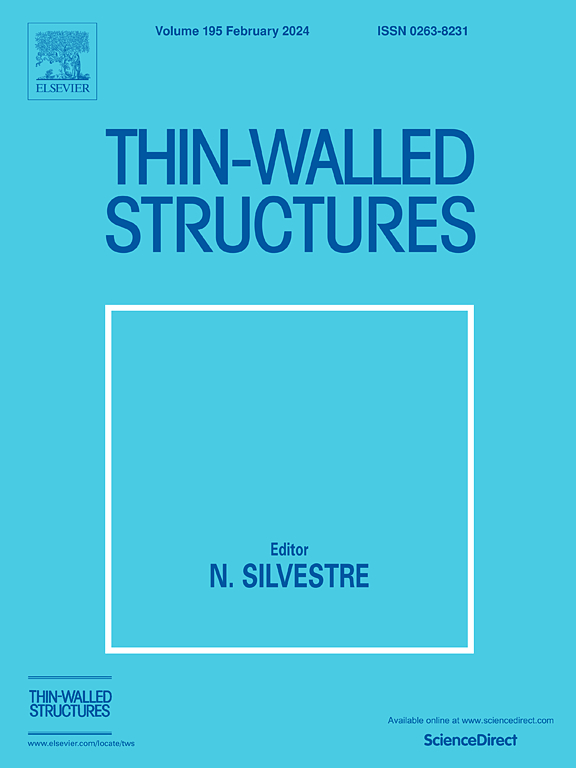基于超空泡弹丸的水下穿甲与爆炸组合破坏特性研究
IF 5.7
1区 工程技术
Q1 ENGINEERING, CIVIL
引用次数: 0
摘要
最近对超空泡弹的研究主要集中在空腔的形成和演变及其水下弹道特性上,而忽略了末端破坏效应。人们很少关注穿甲-爆炸超空泡弹(APESP)的综合损伤效应。因此,本研究比较分析了水下铝合金圆柱形炮弹目标在三种不同载荷(穿甲、爆炸以及穿甲和爆炸组合载荷)作用下的响应过程和破坏模式。本研究探讨了 APESP 的水下组合破坏机理,明确了组合效应下的各个破坏阶段,根据目标响应和破坏模式讨论了穿甲和爆炸组合效应导致破坏的优势,并探讨了爆炸能量耗散的原因。结果表明:APESP 结合了穿甲的局部点损伤特征和水下爆炸的整体面损伤特征。根据载荷阶段和目标响应,APESP 作用下的目标响应过程可分为水动力冲撞阶段、穿透阶段、冲击波阶段、稳定振动阶段和气泡脉动阶段。根据介质和结构的能量关系,可将整个物理系统抽象为一个低频串联弹簧系统(相当于气泡脉动频率)与高频外部能量输入系统。根据稳定振动阶段的目标行为,提出了 "鼓风机效应 "的概念。在施加不同载荷后,目标在稳定状态下的塑性变形分为:水下爆炸;穿甲与爆炸相结合;水下穿甲。超空腔、弹壳和贯穿孔会导致爆炸能量耗散。本文章由计算机程序翻译,如有差异,请以英文原文为准。
Research on combined damage characteristics of underwater armor-piercing and explosion based on supercavitating projectile
Recent studies of supercavitating projectiles primarily focus on the formation and evolution of the cavity, as well as its underwater ballistic characteristics, while neglecting the terminal damage effects. Little attention has been given to exploring the combined damage effects of armor-piercing-explosion supercavitating projectiles (APESP). Therefore, this study comparatively analyzes the response processes and failure modes of an underwater aluminum alloy cylindrical shell target under the action of three different types of loads: armor piercing, explosion, and combined armor-piercing and explosion. This study investigates the underwater combined damage mechanisms of the APESP, clarifies each damage phase under the combined effect, discusses the advantages of damage resulting from the combined armor-piercing and explosion effect based on the target responses and damage modes, and explores the reasons for dissipation of explosion energy. The results show that: the APESP combines localized point damage characteristics of armor piercing with overall surface damage features of underwater explosion. Depending on load stages and target responses, the target response process under the action of the APESP can be divided into the hydrodynamic ram phase, penetration phase, shock wave phase, stable vibration phase, and bubble pulsation phase. The entire physical system can be abstracted as a low-frequency series spring system (equivalent to bubble pulsation frequency) with high-frequency external energy input, based on the energy relationship of the medium and the structure. The concept of the 'blower effect' is proposed based on target behavior during the stable vibration phase. Following the application of different loads, the plastic deformation of the target in a stable state is ranked as: underwater explosion > combined armor-piercing and explosion > underwater armor piercing. Supercavity, shell casing and penetration hole will cause the dissipation of explosion energy.
求助全文
通过发布文献求助,成功后即可免费获取论文全文。
去求助
来源期刊

Thin-Walled Structures
工程技术-工程:土木
CiteScore
9.60
自引率
20.30%
发文量
801
审稿时长
66 days
期刊介绍:
Thin-walled structures comprises an important and growing proportion of engineering construction with areas of application becoming increasingly diverse, ranging from aircraft, bridges, ships and oil rigs to storage vessels, industrial buildings and warehouses.
Many factors, including cost and weight economy, new materials and processes and the growth of powerful methods of analysis have contributed to this growth, and led to the need for a journal which concentrates specifically on structures in which problems arise due to the thinness of the walls. This field includes cold– formed sections, plate and shell structures, reinforced plastics structures and aluminium structures, and is of importance in many branches of engineering.
The primary criterion for consideration of papers in Thin–Walled Structures is that they must be concerned with thin–walled structures or the basic problems inherent in thin–walled structures. Provided this criterion is satisfied no restriction is placed on the type of construction, material or field of application. Papers on theory, experiment, design, etc., are published and it is expected that many papers will contain aspects of all three.
 求助内容:
求助内容: 应助结果提醒方式:
应助结果提醒方式:


